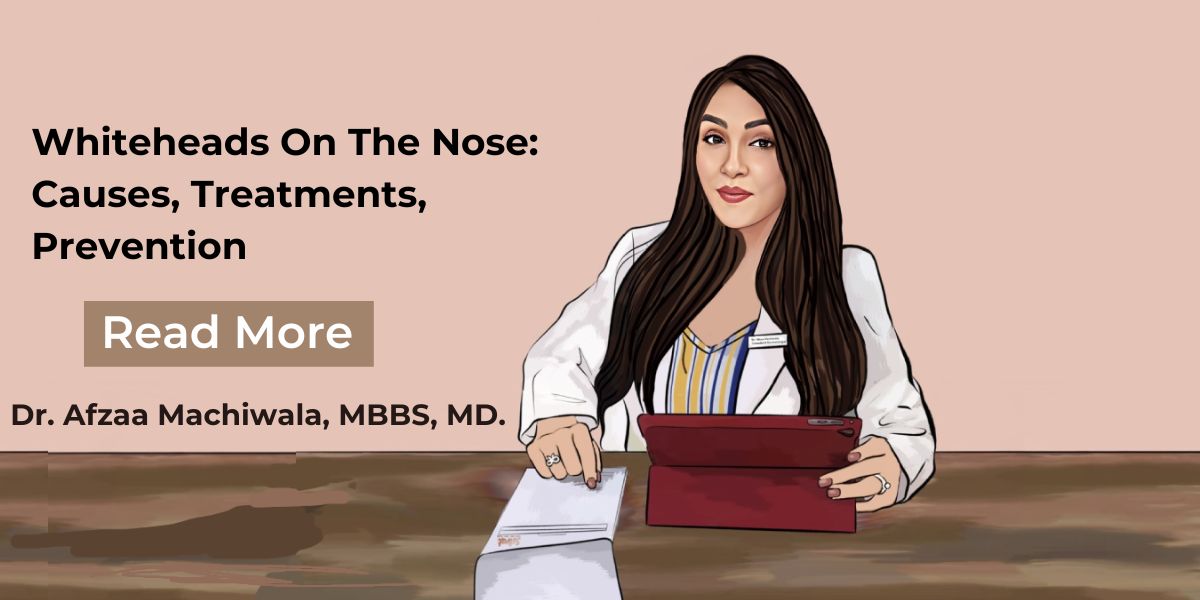


A whitehead on the nose is a small, white bump that appears when the skin’s pores get clogged with oil, dead skin cells, and sometimes bacteria. It looks like a tiny, white spot on the skin and is a common type of acne. Unlike blackheads, which are open at the surface, whiteheads are closed and trapped under the skin’s surface, making them appear white or flesh-colored.
Whiteheads on the nose show up as small, white or flesh-colored bumps. They feel slightly raised when you touch them and have a smooth texture. Unlike some other types of pimples, whiteheads aren’t usually painful or surrounded by red skin.
They tend to cluster on oily parts of the nose and might stick around if not treated. Even though they’re tempting to touch or squeeze, it’s best to leave them alone to avoid skin irritation or infection.
Several factors contribute to the formation of whiteheads on the nose:
1.Excess Oil Production: The nose has more oil glands than other parts of the face, leading to higher oil production and potentially more whiteheads.

2.Poor Hygiene: Not washing your face regularly can allow oil and dirt to accumulate, clogging pores.
3.Hormonal Changes: Fluctuations in hormones can increase oil production, which can lead to acne, including whiteheads.
4.Sweat: If you sweat a lot and don’t clean your face, the sweat can mix with oils and clog your pores.
5.Stress: Being stressed can affect your hormones and skin, contributing to whitehead formation.
6.Genetics: Sometimes, if your family members have acne or whiteheads, you might be more likely to get them too.
7.Diet: Eating a lot of sugary or oily foods might impact your skin and lead to more whiteheads.
If you’re struggling with whiteheads, here are some effective treatments:
1.Topical Treatments: Over-the-counter products containing ingredients like salicylic acid or benzoyl peroxide can help by exfoliating the skin and reducing bacteria.
2.Retinoids: Prescription-strength retinoids can promote cell turnover and prevent the clogging of pores.
3.Professional Treatments: Dermatologists can offer treatments like chemical peels or extraction to remove whiteheads.
4.Warm Compress: Applying a warm compress can help to open the pores and allow for easier cleaning and treatment of whiteheads.
Preventing whiteheads involves a few key skincare practices:
1.Wash Regularly: Wash your face twice daily with a gentle cleanser to remove excess oil and dirt.
2.Avoid Touching Your Face: This can transfer oils and dirt from your hands to your face, exacerbating the problem.
3.Stay Hydrated: Drinking plenty of water helps to keep your skin hydrated and can reduce the likelihood of oil overproduction.
4.Remove Makeup Before Bed: Always thoroughly remove makeup before bed to prevent it from clogging your pores overnight.

Whiteheads on the nose can be effectively managed with the right care and knowledge about their causes. Regular cleansing, using suitable products, and leading a healthy lifestyle are key to prevention. For specialized acne treatment, consult the best dermatologist in Andheri, like Dr. Afzal Machiwala at Sutvakclinic, for personalized advice. Remember, finding the right skincare approach is crucial for clearer skin.
Yes, certain foods, especially those high in sugar and oils, can contribute to the development of acne, including whiteheads.
Yes, frequently touching your nose can transfer bacteria and oils from your hands to your skin, which can clog pores and lead to whiteheads.
No, whiteheads are closed comedones, meaning the pore is covered by skin. Blackheads are open comedones.
To prevent whiteheads, maintain a regular cleansing routine, use non-comedogenic products, exfoliate gently, avoid touching your face, and manage stress and diet.
Not necessarily. While keeping the skin clean helps prevent whiteheads, they can also be caused by factors beyond hygiene, like genetics and hormone fluctuations.
No products in the cart.
WhatsApp us
